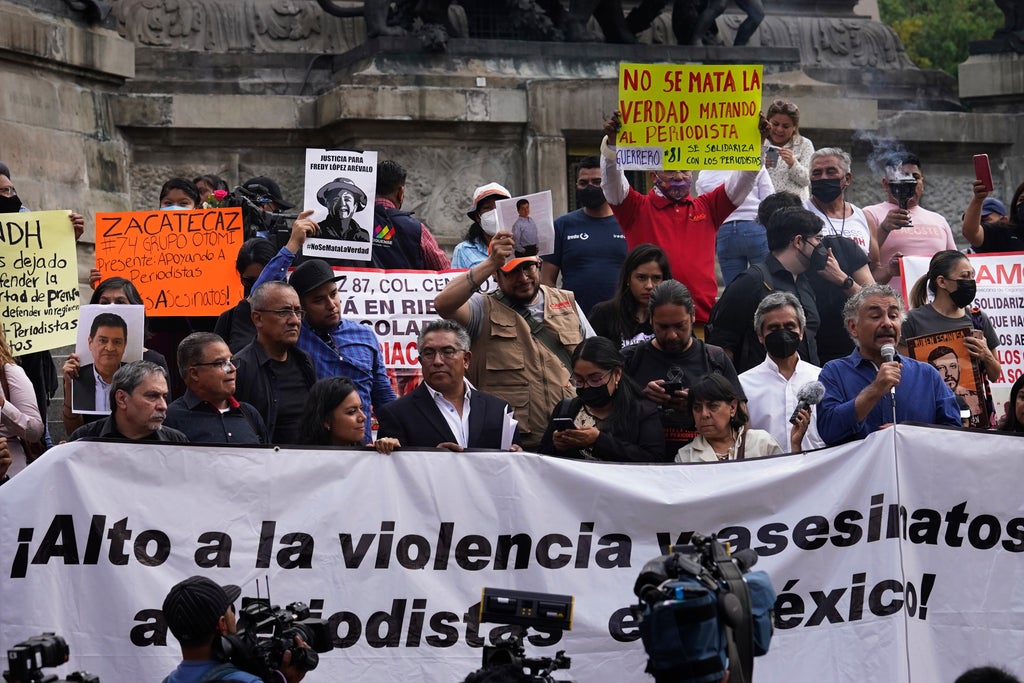
Just as Mexican journalists prepared to protest the killing of a journalist last week, word came Monday that two more were shot to death in the Gulf coast state of Veracruz, raising to 11 the number of such killings in the country this year.
The Veracruz State Prosecutor's Office said via Twitter that it was investigating the killings of Yessenia Mollinedo Falconi and Sheila Johana García Olivera, the director and a reporter, respectively, of the online news site El Veraz in Cosoleacaque.
Veracruz State Prosecutor Verónica Hernández Giadáns said the investigation would be exhaustive, including considering their journalism work as a possible motive in their killing.
The State Commission for Attention To and Protection of Journalists said the two women were attacked outside a convenience store.
“We condemn this attack on Veracruz’s journalism profession, give it prompt monitoring and have opened an investigation,” the commission said.
Their killings came on the heels of the ninth slaying of journalist this year, in the northern state of Sinaloa. Prosecutors there said Thursday that the body of Luis Enrique Ramírez Ramos was found on a dirt road near a junkyard in the state capital, Culiacan.
Prosecutors said that his body was wrapped in black plastic and that he died from multiple blows to the head.
Ramírez Ramos’ news website, “Fuentes Fidedignas,” or “Reliable Sources,” said that he had been abducted near his house hours earlier.
The dizzying pace of killings has made Mexico the deadliest country for journalists to work outside of war zones this year.
On Monday evening, Griselda Triana, wife of Javier Valdez, a journalist slain in 2017, spoke to some 200 journalists gathered at Mexico City’s Angel of Independence monument. The demonstration had originally been scheduled to protest the killing of Ramírez Ramos and those who preceded him.
Valdez, one of Mexico’s best-known journalists killed in recent years, was an award-winning reporter who specialized in covering drug trafficking and organized crime in the northern state of Sinaloa.
“In all this time I haven’t stopped thinking about how easy it is for them to kill a journalist in Mexico,” Triana said. “I feel hurt each time they take the life of so many colleagues.”
“There’s so much anger, indignation, powerlessness knowing that we come here to protest the murder of Luis Enrique Ramírez, (that happened) a few days ago in Culiacan, Sinaloa, and the news of the killing of two women journalists in Veracruz reaches us here,” Triana said. “It’s a whirlpool. The crimes against freedom of expression keep occurring every day. We shouldn’t tolerate it. We have the authority to ask the authorities to put a stop to this slaughter of journalists.”
The victims, like those killed Monday, are most often from small, hyperlocal news outlets. El Veraz operated a Facebook page and appeared to almost exclusively post notices about events or public information from the municipality's government. El Veraz’s motto was “Journalism with Humanity.”
The phone number listed for El Veraz rang to what appeared to be Mollinedo Falconi's cell phone, according to its message.
Cosoleacaque is just off a major east-west route in southeastern Veracruz. Organized crime is present in the area and involved especially in migrant smuggling, but there was no immediate indication of who could have been responsible.
Veracruz Gov. Cuitláhuac García said a search was underway for those responsible.
“We will find the perpetrators of this crime, there will be justice and there will not be impunity like we have said and done in other cases,” García said via Twitter.
Journalists had already scheduled a demonstration for Monday in Mexico City to protest killings of their colleagues, most recently that of Ramírez Ramos in Sinaloa.
Mexico’s state and federal governments have been criticized for neither preventing the killings nor investigating them sufficiently.
While organized crime is often involved in journalist killings, small town officials or politicians with political or criminal motivations are often suspects as well. Journalists running small news outlets in Mexico’s interior are easy targets.
Mexico has a protection program for journalists and human rights defenders, but it was not immediately known whether either Mollinedo Falconi or García Olivera were enrolled.
Participants receive support, such as electronic devices or “panic buttons” to alert the authorities to any threat; surveillance systems in their homes; even bodyguards in some cases. Often authorities recommend that threatened journalists move to another state or the capital to lessen the threat, but that means separating them from their work, livelihood and families.
While President Andrés Manuel López Obrador has promised a “zero impunity” program to investigate such slayings, journalists’ murders, like most homicides in Mexico, are never resolved by authorities. López Obrador has also kept up his regular verbal attacks on journalists critical of his administration.
In February, the Inter American Press Association called on the president to “immediately suspend the aggressions and insults, because such attacks from the top of power encourage violence against the press.”
In March, the European Union approved a resolution that “calls on the authorities, and in particular the highest ones, to refrain from issuing any communication which could stigmatize human rights defenders, journalists and media workers, exacerbate the atmosphere against them or distort their lines of investigation.”







